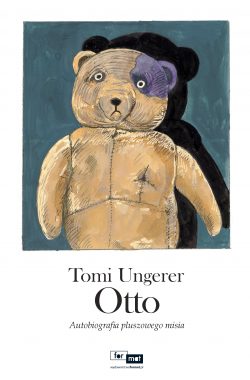Author: Tomi Ungerer
Illustrator: Tomi Ungerer
Translator: Michał Rusinek
Year: 2011
Publisher: Format
Place of publishing: Wrocław
Pages: 32
ISBN: 9788361488729
Notes: Translation from English (1999).
Translations:
- Otto: Autobiografía de un osito de peluche, trans. Susana Andrés, Barcelona: Ediciones B, 2011, pp. 32, ISBN: 9788466648707;
- Otto: Autobiografia di un orsacchiotto, trans. Caterina Ottaviani, Milano: Mandadori, 2003, pp. 32, ISBN: 9788804515272;
- Otto: Autobiographie d’un ours en peluche, trans. Florence Seyvos, Paris: École des Loisirs, 1999, pp. 32, ISBN: 9782211055437;
- Otto: Autobiographie eines Teddybären, trans. Anna Cramer-Klett, Zürich: Diogenes, 1999, pp. 32, ISBN: 9783257008579;
- Otto: Eñvorennoù un arzhig kof plouz, trans. Mark Kerrain, Saint-Brieg: Breton, 2006, pp. 32, ISBN: 9782912905741;
- Otto: Biography of a Teddy Bear, Boulder, Colo.: Roberts Rinehart Publishers, 1999, pp. 32, ISBN: 9781570983047;
- Otto: The Autobiography of a Teddy Bear, New York: Phaidon, 2010, pp. 32, ISBN: 9780714857664;
- オットー: 戦火をくぐったテディベア, trans. 鏡哲生, 東京: 評論社, 2004, pp. 32, ISBN: 9784566008007;
- אוטו: אוטוביוגרפיה של דבון צעצוע, trans. מיכאל דק, רמת השרון :צלטנר,
I 2014, pp. 32, ISBN: 891820409.

Otto is a first-person story told from the point of view of the eponymous character: a plush bear sewn in pre-war Germany. At the start of his “life,” Otto is given to a Jewish boy by the name of David. Before his family’s forced displacement, David hands Otto over to his German friend Oskar. Along with the child character, the teddy bear survives an aerial bombing of the city. Then, he is brought to the United States by an American soldier named Charlie. After numerous twists of fate, Otto finds himself in the window of an antique store, and is later bought by Oskar as an old man. And this is not the end of Otto’s adventure…
Tomi Ungerer’s picturebook talks about the Holocaust through the perspective of a toy which is inanimate, but able to perceive the world and feel emotions. This could be considered as an attempt to show a non-anthropocentric experience of the war and the Shoah. The author decided to present a variety of moral stances and character types, including some Germans’ compassion for their Jewish compatriots, friendships between “regular” people and the persecuted, or the suffering of German civilians. The Holocaust directly affects one character, David, who is the only member of his family to survive the war.
Bibliography:
- Biernacka-Licznar, K., Jamróz-Stolarska, E., Paprocka, N., Lilipucia rewolucja. Awangardowe wydawnictwa dla dzieci i młodzieży w Polsce w latach 2000–2015. Produkcja wydawnicza. Bibliografia, Warszawa 2018 (pp. 59–60);
- Bajorek, A., Zabawka jako historyczny artefakt w niemieckiej literaturze i kulturze dziecięcej, „Filoteknos”, no. 9, 2019, pp. 300–308 (pp. 305–306);
- Gajownik, S., II wojna światowa we współczesnej literaturze dla dzieci i młodzieży, [in:] Historia – pamięć – edukacja w edukacji humanistycznej, vol. 2: Literatura i kultura, eds. Z. Budrewicz, M. Sienko, Kraków 2013, pp. 167–179 (pp. 174–175);
- Ippoldt, L., Dziecko a wojna – literatura dla dzieci o tematyce wojennej na wybranych przykładach polsko- i niemieckojęzycznych, „Orbis Linguarum”, no. 48, 2018, pp. 501–504 (p. 502);
- Jeziorkowska-Polakowska, A., „biała plamka na tle MURU to ja…” – angielski buldog opowiada o Zagładzie, [in:] (Nie)zapomniane zwierzęta, eds. E. Łoch, D. Piechota, A. Trześniewska-Nowak, Gdańsk 2021, pp. 129–161 (p. 132, fn. 6);
- Rybak, K., Obrazowanie Zagłady. Narracje holokaustowe w polskiej literaturze XXI wieku dla dzieci i młodzieży, Warszawa 2023;
- Skowera, M., Różne odcienie dzieciństwa w utworze Agnieszki Suchowierskiej Mat i świat, „Litteraria Copernicana”, no. 3 (23), 2017, pp. 127–138 (p. 131);
- Slany, K., Zabawka jako medium pamięci o Holocauście na przykładzie picturebooka Otto. Autobiografia pluszowego misia Tomiego Ungerera, „Ruch Literacki”, vol. LIX, no. 4, 2018, pp. 441–456;
- Wójcik-Dudek, M., Kiedy mały Srulek staje się bohaterem literackim – Holokaust w literaturze dla dzieci i młodzieży, [in:] Żydowskie dziecko, eds. A. Jeziorkowska- Polakowska, A. Karczewska, Lublin 2013, pp. 245–255 (pp. 253–254);
- Wójcik-Dudek, M., Dziewczyny i wojna (na podstawie wybranych przykładów literatury dla dzieci i młodzieży), [in:] Uwięzione w grzeczności. Obrazy kobiecych inności w tekstach literackich, eds. B. Walęciuk-Dejneka, Ł. A. Wawryniuk, Kraków 2015, pp. 153–164 (p. 162, fn. 26);
- Wójcik-Dudek, M., Między udziecinnieniem a infantylizacją Zagłady, [in:] Światy dzieciństwa. Infantylizacje w literaturze i kulturze, eds. M. Chrobak, K. Wądolny- Tatar, Kraków 2016, pp. 435–449 (p. 438, fn. 11).